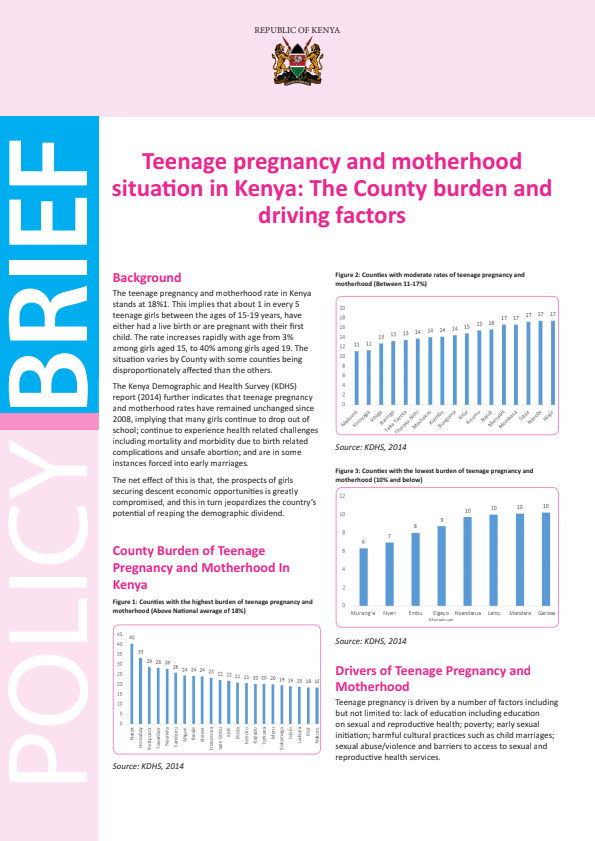Policy Briefs

This brief summarises results of the study carried out to assess the potential demographic dividend (DD) that Rwanda can earn under various policy scenarios and identify the policy actions that the country can invest in to harness the DD. The study involved a review of the country’s demographic and economic policies and programmes, modelling the DD using the DemDiv modelling tool, and interactive discussions with various stakeholders to identify key policy options for harnessing the DD.

This brief is derived from the Rwanda Demographic Dividend (DD) study, which showed that reducing birth rates from 4.2 to 2.3 births per woman by 2050 would produce an age structure with more working age people than dependents. This would propel the country to upper-income status with GDP per capita of US$ 12,555 by 2050.

This brief highlights the key policy and programme options that can help accelerate economic productivity and job creation in Rwanda to enable the country earn the DD. The brief draws on findings of the Rwanda DD study that showed that the country can graduate to middle-income level with per capita GDP of US$ 4,014 by 2035 and to a high-income country with per capita GDP of US$ 12,555 by 2050 if the country adopts an integrated investment model that simultaneously prioritises investments to facilitate voluntary decline in fertility, education, health and job-focused economic reforms.

This policy brief presents the challenges facing the sustainable financing of Malawi’s national health research system, the commitments already made to improve the country’s health research as well as individualized case studies of countries Malawi could benchmark its own research funding mechanism. Finally, this policy brief also recommends specific reforms the respective Ministries and National agencies should implement to support research generation and utilization for decision-making.

The demographic dividend (DD) represents a golden opportunity for many developing countries to experience accelerated economic growth as a result of population changes. Africa in particular is ideally positioned to (1) create the opportunity for a DD and (2) develop an environment conducive to reaping the economic benefits of the DD. The time for sustained action to take advantage of this potential is now.

As a result of a “first” demographic transition, age structures of populations become older. Economically, people often move into higher-paying jobs and countries experience higher per capita income. These social and economic changes motivate people to accumulate greater personal wealth—a process known as the “second” demographic dividend.

The teenage pregnancy and motherhood rate in Kenya stands at 18%. This implies that about 1 in every 5 teenage girls between the ages of 15-19 years, have either had a live birth or are pregnant with their first child. The rate increases rapidly with age from 3% among girls aged 15, to 40% among girls aged 19. The situation varies by County with some counties being disproportionately affected than the others.

For Malawi to achieve inclusive development and maximise its demographic dividend, the government and private sector should focus on economic reforms that create adequate decent create jobs to keep pace with the rapidly rising youthful working-age population.

A healthy workforce is critical to support Malawi to harness the demographic dividend and transform into a globally competitive, technologically-driven middle-income country.

Kenya continues to record high levels of maternal deaths and poor maternal health outcomes. According to the Kenya Demographic and Health Survey (KDHS) 2014, the national maternal mortality ratio is currently at 362 deaths per 100,000 live births, a decrease from 488 per 100,000 in 2008. This is well above the MDG target of 147 per 100,000 by 2015. It is estimated that for every woman who dies in childbirth in Kenya, more than 20-30 women suffer serious injury or disability due to complications during pregnancy or delivery (Kenya National Bureau of Statistics, 2014).

The Constitution of Kenya 2010 recognises that every Kenyan has a right to the highest attainable standard of health. Even then, many Kenyans still lack access to quality health care, and key health indicators remain poor. For instance, according to the 2014 Kenya Demographic and Health Survey (KDHS 2014), maternal mortality ratio stands at 366 per 100,000; infant mortality rate at 39 per 1,000 live births; and under-five mortality rate at 52 per 1,000.

Water surveillance is an investigative activity undertaken to identify and evaluate factors associated with drinking water that could pose a health risk. Surveillance contributes to the protection of public health by promoting improvement of the quality, safety, quantity, coverage, cost, and continuity of water supplies. It is also both preventive in the sense that it detects risks so that action may be taken before public health problems occur.

